BUILDING A DECK? Here are some deck building basics.
A deck is basically a floor structure supported on posts. Loads on the deck from people, furniture, snow, etc. are transferred from the decking, onto joists, to beams, down posts, to foundations and into the soil below. All of these components play an important role in the function of the deck and must be sized and constructed properly to make the deck safe.
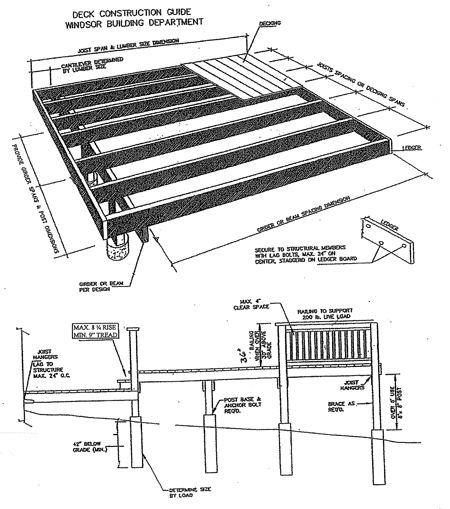
GUARDS
When guards are required, porches, balconies or raised floor surfaces located more than 30 inches (762 mm) above the floor or grade below shall have guards not less than 36 inches (914 mm) in height. Open sides of stairs with a total rise of more than 30 inches (762 mm) above the floor or grade below shall have guards not less than 34 inches (864 mm) in height measured vertically from the nosing of the treads. Porches and decks which are enclosed with insect screening shall be provided with guards where the walking surface is located more than 30 inches (762 mm) above the floor or grade below. 8312.2 Guard opening limitations. Required guards on open sides of stairways, raised floor areas, balconies and porches shall have intermediate rails or ornamental closures which do not allow passage of a sphere 4 inches (102 mm) or more in diameter.
Exceptions:
- The triangular openings formed by the riser, tread and bottom rail of a guard at the open side of a stairway are permitted to be of such a size that a sphere 6 inches (152 mm) cannot pass through.
- Openings for required guards on the sides of stair treads shall not allow a sphere 4 3/8 inches (107 mm) to pass through.
Openings for required guards on the sides of stair treads shall not allow a sphere 4 3/8 inches (107 mm) to pass through.
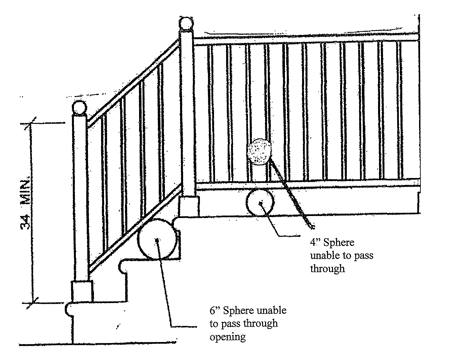
STAIRWAYS
WIDTH: Stairways shall not be less than 36 inches in clear width at all points above the permitted handrail height and below the required headroom height. Handrails shall not project more than 4.5 inches on either side of the stairway and the minimum clear width of the stairway at and below the handrail height, including treads and landings, shall not be less than 31.5 inches where a handrail is installed on one side and 27″ where handrails are provided on both sides.
HEADROOM: The minimum headroom in all parts of the stairway shall not be less than 6 feet 8 inches measured vertically from the sloped plan adjoining the tread nosing or from the floor surface of the landing or platform.
RISER HEIGHT: The maximum riser height shall be 8 ¼ inches. The riser shall be measured vertically between leading edges of adjacent treads. The greatest riser height within any flight of stairs shall not exceed the smallest by more than 3/8″.
TREAD DEPTH: The minimum tread depth shall be 9 inches. The tread depth shall be measured horizontally between the vertical planes of the foremost projection of adjacent treads and at a right angle to the tread’s leading edge. The greatest tread depth within any flight of stairs shall not exceed the smallest by more than 3/8 inch.
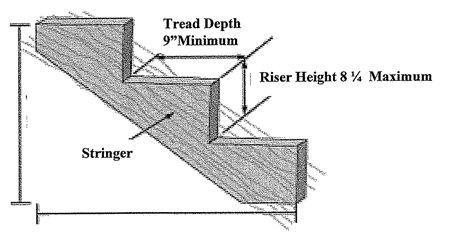
HANDRAILS
HANDRAIL GRIP SIZE: All required handrails shall be of one of the following types or provide equivalent grasp ability.
Type I: Handrails with a circular cross section shall have an outside diameter of a least 1 ¼ inches (32 mm) and not greater than 2 inches (51 mm). If the, handrail is not circular it shall have a perimeter dimension of at least 4 inches (102 mm) and not greater than 6 ¼ inches (160 mm) with a maximum cross section of a dimension of 2 ¼ inches (57 mm).
Type II: Handrails with a perimeter greater than 6 ¼ inches (160 mm) shall provide a grasp able finger recess area on both sides of the profile. The finger recess shall begin within a distance of ¾ inch (19 mm) measured vertically from the tallest portion of the profile and achieve a depth of at least 5/16 inch (8 mm) within 7/8 inch (22 mm) below the widest portion of the profile. This required depth shall continue for at least 3/8″ (10 mm) to a level that is not less than 1 ¾ inches (45 mm) below the tallest portion of the profile. The minimum width of the handrail above the recess shall be 1 ¼ inches (32 mm) to a maximum of 2 ¾ inches (70 mm). Edges shall have a minimum radius of 0.01 inches (0.25 mm).
CONTINUITY: Handrails for stairways shall be continuous for the full length of each flight, from a point directly above the top riser of the flight to a point directly above the lowest riser of the flight. Handrail ends shall be returned to a wall or shall terminate in newel posts or safety terminations. Handrails adjacent to a wall shall have a space of not less than 1 ½ inch between the wall and the handrails.
Exceptions:
- Handrails shall be permitted to be interrupted by a newel post at a level landing.
- The use of a volute, turnout, starting easing or starting newell shall be permitted over the lowest tread.
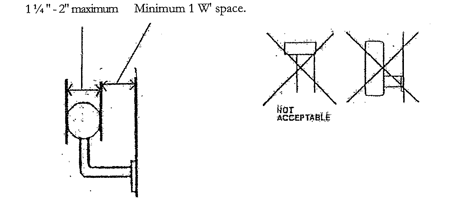
DECK JOIST TABLE
| Southern Pine | 2×6 | 16″ on center | 9’5″ |
| Southern Pine | 2×8 | 16″ on center | 12’5″ |
| Southern Pine | 2×10 | 16″ on center | 15’10” |
| Southern Pine | 2×12 | 16″ on center | 18’10” |
The above spans are from Southern Pine Joist and Rafter span chart for a 40-pound per square foot (psf) live load and a 10 psf dead load with a 360 deflection and a moisture content above 19% due to exposed exterior location. Additional span information is available in the Building Department.
Posts to girder attachment should be braced to prevent girder from “rolling.” Any seams or splices in the girder must be over the posts.
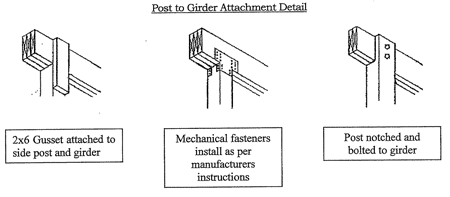
Decks not supported by dwelling do not need frost protection footings.
- Wood must be pressure treated or naturally decay resistant.
- Fasteners must be compatible with wood used.
- Piers are required to be 42″ deep for frost protection. Piers should be minimum 8″ round and depending on size of deck possibly larger.
- Posts must be of sufficient size to support loads, and positively attached to piers.
- Beams must be positively attached to posts with gussets or hardware designed for this purpose.
- All splices in beams must be supported by posts. No mid-span splices. Beams required to have minimum 1 ½” bearing on wood and 3″ on concrete.
- Joists shall be supported by properly sized hanger, or minimum 2″x2″ ledger strip.
- If deck is greater than 5′ high, depending on size and structural details, diagonal bracing may be required at posts.
IMPORTANT INFORMATION REGARDING DECKS AND HARDWARE
Connecticut State Building Code Section R319.3 amends the 2003 International Residential Code regarding fasteners allowed to be used on pressure preservative and fire retardant wood as follows:
(Amd) R319.3 Fasteners and weight bearing connecting devices used for pressure preservative and fire-retardant treated wood shall be of stainless steel, silicon bronze, copper, G185 galvanized steel, or shall be hot-dipped after fabrication.
It is very important that when you purchase hardware, including lag screws, washers, joist hangers, screws and all other fasteners in contact with pressure treated wood, it meet these standards, or excessive corrosion will result.
In addition aluminum flashing cannot come in contact with preservative treated wood unless it is painted or coated with material to prevent contact with lumber.
Do not use old hardware on new preservative treated lumber either. There is a wealth of information available on the internet if you wish to further research this issue.
As an example: If purchasing Simpson hardware for a 2×8 joist hanger their designation of LUS 28 would not be acceptable but would have to be stamped with LUS28Z.
The “Z” designation shows G185 standard is met and “HDG” designation shows hot dipped galvanized standard is met.
Of course you may also use the other materials including stainless steel, copper or silicon bronze, but this material is typically more expensive.
